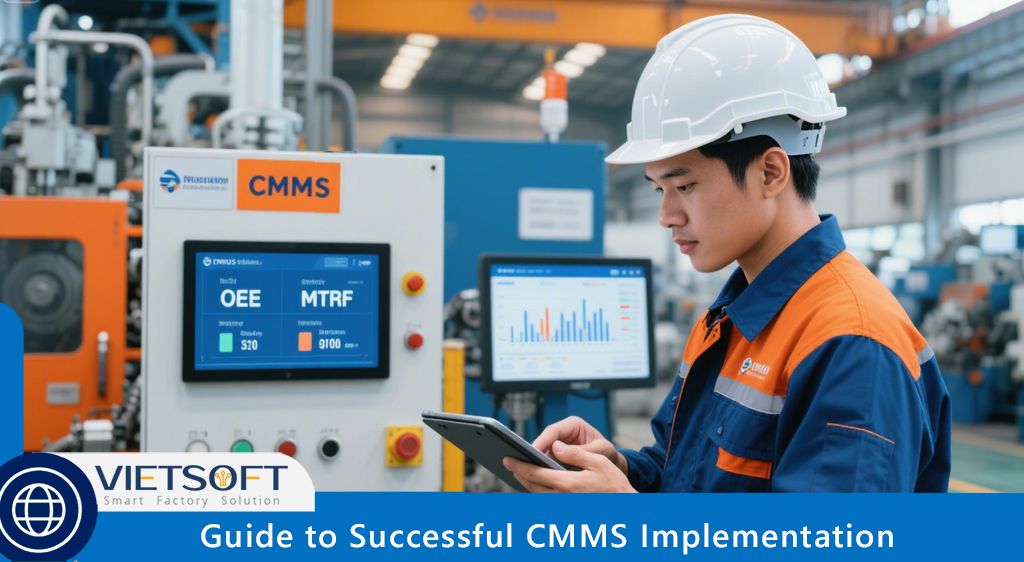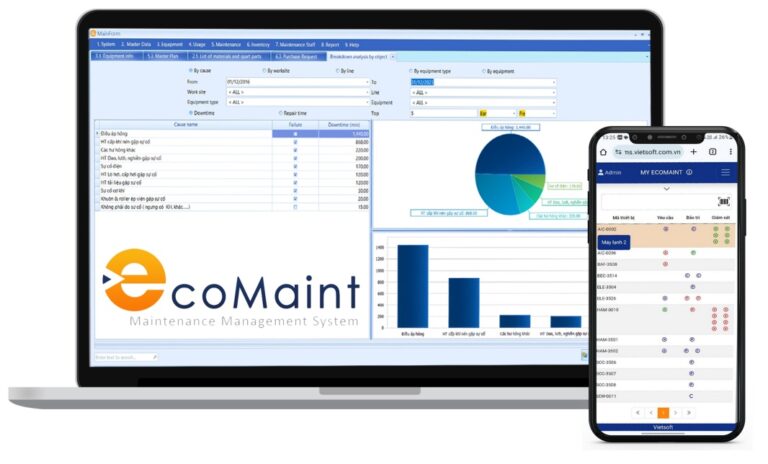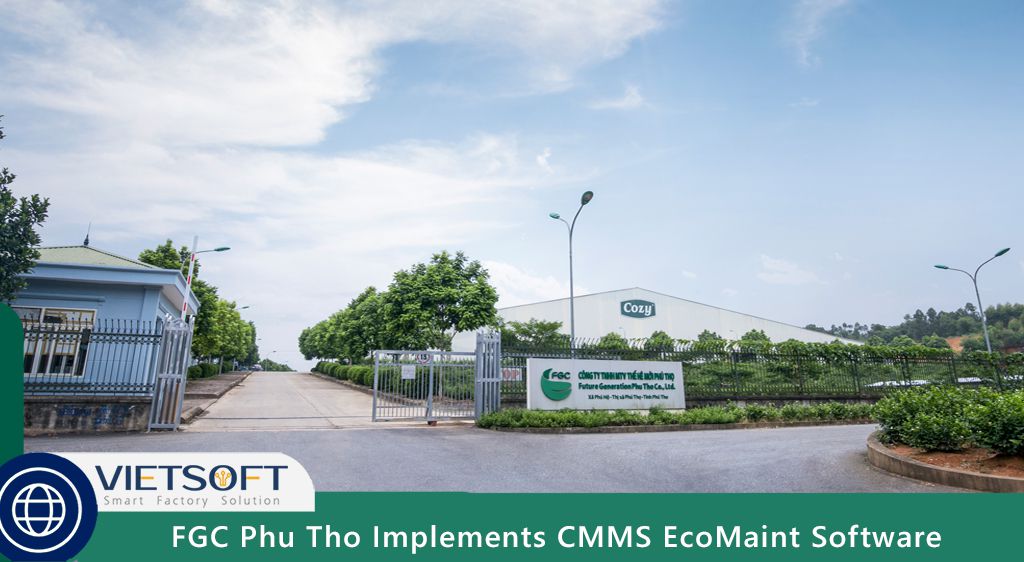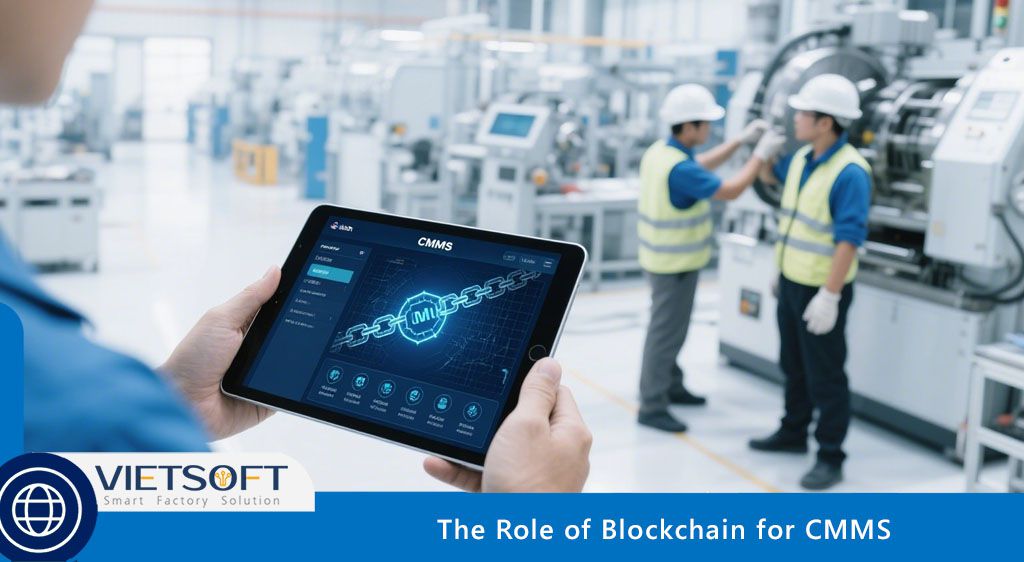
In today’s fast-paced industrial landscape, effective maintenance management is the backbone of operational efficiency. A Computerized Maintenance Management System (CMMS) is a powerful tool that transforms how organizations manage their assets, streamline workflows, and optimize maintenance processes. Implementing a CMMS, however, is a strategic endeavor that requires careful planning, stakeholder alignment, and a focus on long-term success. This guide, provides a detailed roadmap for achieving a successful CMMS implementation tailored to the needs of maintenance professionals in Vietnam and beyond.
With the global CMMS market projected to grow from $982.2 million in 2023 to $1.9 billion by 2030, adopting a CMMS like EcoMaint by Vietsoft can position your organization at the forefront of operational excellence.
I. What Is a CMMS and Why Is It Essential?
A Computerized Maintenance Management System (CMMS) is a software solution designed to centralize and automate maintenance activities, including work order management, asset tracking, and preventive maintenance scheduling. Unlike traditional paper-based or spreadsheet-driven methods, a CMMS provides real-time data, mobile accessibility, and advanced analytics to enhance decision-making and operational efficiency.
II. Key Benefits of CMMS
- Centralized Asset Management: Consolidates all asset-related data, such as maintenance histories, warranties, and service schedules, into a single platform for easy access.
- Proactive Maintenance: Shifts from reactive to preventive and predictive maintenance, reducing downtime by up to 32%, as reported in industry studies.
- Cost Savings: Minimizes emergency repairs and labor costs, with some organizations saving up to 25% on maintenance expenses within the first year.
- Enhanced Productivity: Streamlines work order processes, improving completion rates by as much as 53%, according to the 2024 State of Industrial Maintenance Report.
- Extended Asset Lifespan: Regular maintenance schedules can extend equipment life by several years, maximizing return on investment.
- Improved Reporting: Provides detailed analytics for tracking key performance indicators (KPIs) like Mean Time Between Failure (MTBF) and Overall Equipment Effectiveness (OEE).
For example, a Vietnamese manufacturing plant using EcoMaint by Vietsoft reduced unplanned downtime by 20% within six months by leveraging automated work order tracking and predictive maintenance alerts. This demonstrates the transformative potential of a well-implemented CMMS.
III. Why Prioritize CMMS Implementation Now?
As industries in Vietnam embrace digital transformation, the demand for efficient maintenance systems is skyrocketing. A CMMS not only streamlines operations but also aligns with modern trends like Industry 4.0, where data-driven decision-making is critical. Implementing a CMMS now positions your organization to:
- Stay competitive in a rapidly evolving market.
- Reduce operational costs amidst rising economic pressures.
- Meet regulatory compliance requirements with accurate maintenance records.
- Enhance employee satisfaction by reducing manual workloads and improving accountability.
With CMMS Software, businesses can seamlessly transition to a proactive maintenance model, ensuring long-term sustainability and growth. Curious about how EcoMaint can transform your operations? Explore Vietsoft’s CMMS solutions for a tailored approach to maintenance excellence.
IV. Key Factors for Choosing the Right CMMS Software
Selecting the right CMMS is the foundation of a successful implementation. Here are critical factors to consider:
1. Customization and Flexibility
A CMMS should align with your organization’s unique workflows. For instance, EcoMaint allows customization of work orders, asset categories, and reporting dashboards to match your team’s terminology and processes, ensuring a seamless transition.
2. User-Friendly Interface
An intuitive interface reduces the learning curve and encourages user adoption. A Vietnamese textile factory reported a 30% increase in technician productivity after adopting a user-friendly CMMS like EcoMaint, which simplified task assignments and mobile access.
3. Preventive and Predictive Maintenance Capabilities
Look for a CMMS that supports automated scheduling and integrates with IoT devices for predictive maintenance. This feature helps anticipate equipment failures, reducing downtime by up to 40% in some cases.
4. Mobile Accessibility
Mobile access allows technicians to update work orders, access asset data, and communicate in real time. For example, EcoMaint’s mobile app enables field technicians to scan QR codes on equipment, instantly retrieving maintenance histories and submitting work requests.
5. Robust Reporting and Analytics
Advanced analytics help track KPIs like Mean Time to Repair (MTTR) and Overall Equipment Effectiveness (OEE). These insights enable data-driven decisions to optimize maintenance strategies.
6. Scalability
Choose a system that grows with your organization. EcoMaint supports scalability, accommodating additional users, assets, and locations as your business expands.
7. Vendor Support and Training
A reliable vendor provides ongoing support and comprehensive training. Vietsoft’s dedicated customer success team ensures smooth onboarding and continuous assistance, as evidenced by a Ho Chi Minh City-based factory that achieved full CMMS adoption within three weeks with Vietsoft’s support.
V. Steps for a Successful CMMS Implementation
A structured approach is essential for a seamless CMMS implementation. Below is a step-by-step guide tailored for maintenance professionals:
1. Step 1: Assess Current Maintenance Processes
Begin by evaluating your existing maintenance practices. Identify pain points, such as frequent equipment breakdowns or inefficient work order tracking. For example, if your planned maintenance percentage (PMP) is below 50%, a CMMS can help increase it to the industry benchmark of 80%.
2. Step 2: Define Clear Objectives and KPIs
Set specific, measurable goals, such as reducing downtime by 20% or improving work order completion rates by 40%. Common KPIs to track include:
- MTBF: Measures average time between equipment failures. Formula: Total operational time ÷ Number of failures.
- MTTR: Tracks average repair time. Formula: Total repair time ÷ Number of repairs.
- OEE: Evaluates equipment efficiency. Formula: Availability × Performance × Quality.
- Work Order Completion Rate: Percentage of completed work orders within a set period.
3. Step 3: Secure Stakeholder Buy-In
Engage management and technicians early to align on goals. Present data-driven arguments, such as potential cost savings or improved asset reliability, to gain approval. For instance, a Hanoi-based chemical plant secured funding for EcoMaint by demonstrating a projected 15% reduction in maintenance costs.
4. Step 4: Form an Implementation Team
Create a cross-functional team, including maintenance managers, technicians, IT staff, and a management liaison. This team oversees data migration, training, and system testing.
5. Step 5: Develop a Detailed Timeline
A typical CMMS implementation timeline spans 4–8 weeks, depending on organizational size and complexity. Here’s an example using EcoMaint:
- Week 1: Kickoff meeting with Vietsoft’s team to define objectives and gather data (e.g., asset lists, maintenance schedules).
- Week 2: Data migration and system configuration, including customizing workflows and setting up QR codes.
- Week 3: Team training sessions, covering software navigation and mobile app usage.
- Week 4: Pilot testing with a small group, followed by full system launch and ongoing support.
6. Step 6: Migrate and Organize Data
Accurate data migration is critical. Compile asset data, maintenance histories, and schedules into a standardized format (e.g., Excel or CSV). Vietsoft’s team assists with batch imports, ensuring error-free data transfer.
7. Step 7: Train Your Team
Provide comprehensive training tailored to different roles. For example, technicians learn to use the mobile app, while managers explore reporting tools. EcoMaint offers interactive workshops and online tutorials to support diverse learning styles.
8. Step 8: Test and Launch
Conduct a pilot program to identify issues before full rollout. After addressing feedback, launch the CMMS and monitor performance closely.
9. Step 9: Monitor and Optimize
Track KPIs regularly and gather user feedback to refine processes. For instance, a Da Nang-based packaging company used EcoMaint’s analytics to reduce MTTR by 25% within three months.
VI. Overcoming Common CMMS Implementation Challenges
Even with careful planning, challenges can arise. Here’s how to address them:
1. Resistance to Change
Technicians may resist adopting new technology. Counter this by involving them in the selection process and highlighting benefits, such as reduced manual tasks. Regular feedback sessions can also build trust.
2. Inaccurate Data
Incomplete or inconsistent data can hinder performance. Conduct thorough data audits before migration and leverage Vietsoft’s support for seamless setup.
3. Insufficient Training
Lack of training leads to underutilization. EcoMaint provides ongoing training resources, ensuring all users are confident in using the system.
4. High Implementation Costs
While initial costs may seem daunting, view them as a long-term investment. A Vietnamese steel manufacturer recouped its EcoMaint investment within six months through reduced downtime and repair costs.
5. Losing Momentum
Maintain momentum by setting clear milestones and celebrating small wins, such as completing the first 100 work orders through the CMMS.
VII. Best Practices for Long-Term CMMS Success
To maximize the value of your CMMS implementation, adopt these best practices:
- Start with a Pilot Program: Test the CMMS with a small group to identify and resolve issues early.
- Prioritize User Engagement: Foster enthusiasm through regular training and recognition of user achievements.
- Leverage Analytics: Use CMMS reports to identify trends and optimize maintenance strategies.
- Maintain Regular Updates: Stay current with software updates to access new features and improvements.
- Expand Usage: Integrate the CMMS with other departments, such as inventory or operations, for organization-wide benefits.
VIII. Measuring CMMS Implementation Success
Track these KPIs to evaluate your CMMS implementation:
- Downtime Reduction: Aim for a 20–30% decrease in unplanned downtime.
- Cost Savings: Monitor reductions in repair and labor costs. For example, a food processing plant saved $50,000 annually using EcoMaint.
- Work Order Efficiency: Track completion rates to ensure tasks are completed on time.
- Asset Reliability: Measure MTBF to assess equipment performance improvements.
IX. Why Choose EcoMaint by Vietsoft for Your CMMS Implementation?
For businesses in Vietnam seeking a reliable and scalable CMMS, EcoMaint by Vietsoft offers a tailored solution designed to meet the unique needs of local industries. With features like mobile accessibility, predictive maintenance, and customizable workflows, EcoMaint empowers maintenance teams to achieve operational excellence. Vietsoft’s dedicated support team provides hands-on training and ongoing assistance, ensuring a smooth implementation and long-term success.
Ready to transform your maintenance operations? Learn more about CMMS EcoMaint here.
Contact us for consultation via hotline: 0986778578 or email: sales@vietsoft.com.vn.
X. Conclusion
A successful CMMS implementation is a game-changer for maintenance teams, enabling proactive strategies, cost savings, and enhanced productivity. By following a structured approach—assessing needs, choosing the right software, securing stakeholder buy-in, and providing robust training—you can unlock the full potential of your CMMS. With EcoMaint by Vietsoft, your organization can navigate the complexities of implementation with confidence, achieving measurable results and long-term success.
Invest in a CMMS today to future-proof your maintenance operations and stay ahead in Vietnam’s competitive industrial landscape. For more insights, visit Vietsoft’s website and start your journey to maintenance excellence.




